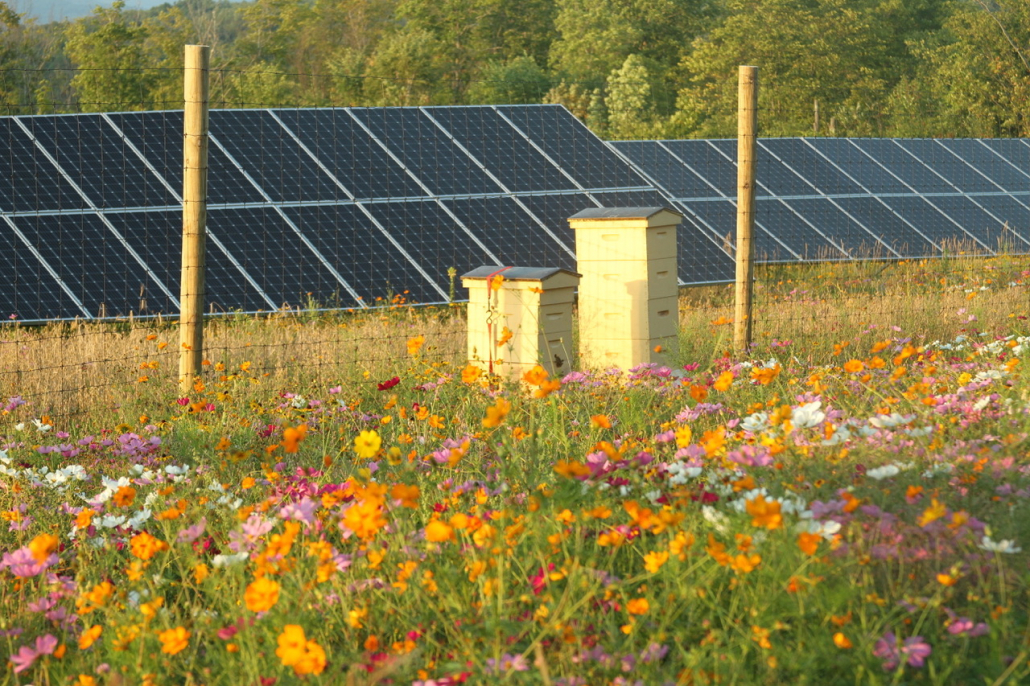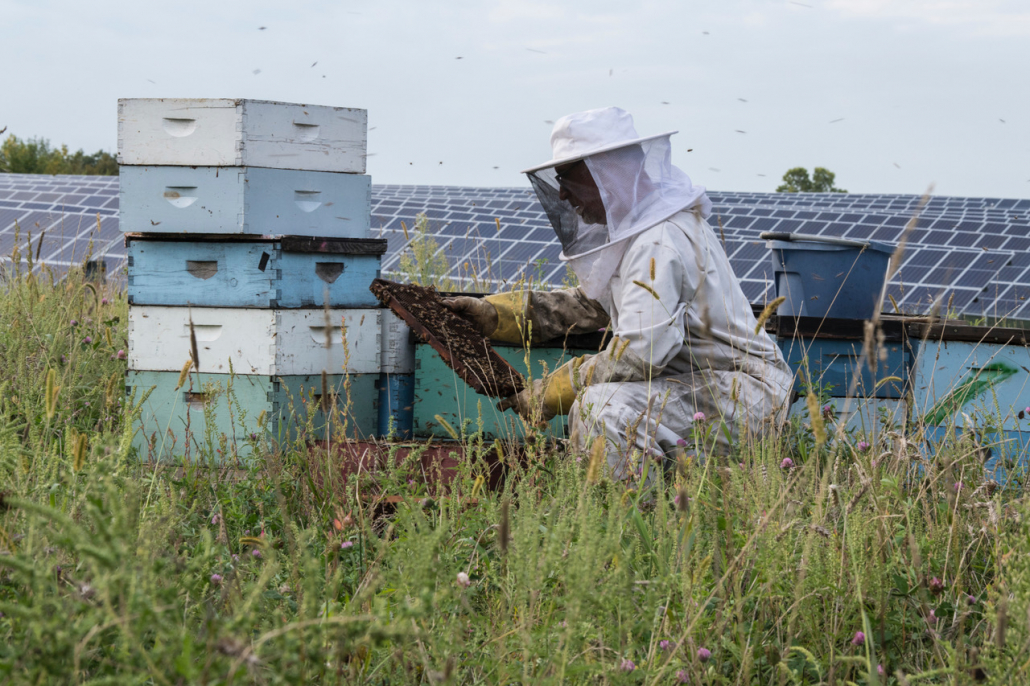In this explainer video, AgriSolar Clearinghouse Director Stacie Peterson offers up five things to know about agrisolar and pollinator habitat and beekeeping.
Tag Archive for: Beekeeping
by Emily Griffith of Renewable NorthWest
Renewable Northwest and a small workgroup are preparing an update to the 2019 report, Dual-Use Solar in the Pacific Northwest: A Way Forward, in response to the changing landscape of agrivoltaics (also referred to as dual-use solar) in the region. This blog will explain the need for a fresh look at dual-use in the Pacific Northwest and describe some of the themes important to the conversation.
Why Do We Need to Revisit Dual-use Solar?
The Biden Administration recently set a goal of reaching 100% carbon-free electricity by 2035. Many states have similar requirements of reaching net-zero GHG emissions. To reach these targets, extensive buildout of solar energy will be a cornerstone of the evolving energy grid. Dual-use solar allows farmers to use their land both as farmland and as a site to generate electricity (and additional income).
In Renewable Northwest’s 2019 report, staff explored the potential and practicality of dual-use solar by looking at advantages and disadvantages, policies, project examples, and best practices. Given the increased attention agrivoltaics has received recently, including federal research investments and policy changes, it’s time to revisit the report. The updated report (to be completed in spring 2023) will explore recent updates in agrivoltaics. Here is what you can expect:
What Has Not Changed?
The conversation around dual-use in the Pacific Northwest is still in early stages. To date, the region still does not have many dual-use projects, but some solar and pollinator projects do exist. For example, Pine Gate Renewables’ Eagle Point Solar is a 13-MW solar and pollinator project located on 41 acres in Medford, Oregon. Previously, the land was used for dairy grazing. Now, the site contains a diverse seed mix of pollinating flowers with over 30 types of native flowers and grasses. Old Sol Apiaries is a business based in southern Oregon that provides bees for honey makers and commercial pollinators. Bees forage on native pollinator plants under Pine Gate’s panels. They also provide bees at other solar-pollinator locations, such as a 73-acre project in Clackamas County, Oregon.

There are a few reasons why dual-use is still not as widely used in this region as it is in others. For instance, there are still policy barriers. In fact, every year there are regular efforts pushing back against solar development by legislators in the Northwest. For example, in Oregon, the Land Conservation and Development Commission issued a rulemaking in 2019 limiting the amount of land to 12 acres that a farmer could use for a solar project located on high-value farmland. However, there was potential for counties to issue ordinances that could increase to 20 acres for dual-use projects. The difficulty with this rulemaking was that it sunsetted after two and a half years, and counties did not have much of a chance to develop an ordinance before the sunset. Additionally, counties in Washington state are continuing to develop ordinances that limit renewable energy development, including potential dual-use projects.
Agrivoltaics continues to be a challenging environment. The idea of agrivoltaics originated in Europe and is just gaining momentum in the U.S. A recent article by Jeff Turrentine at the National Resources Defense Council (NRDC) states that in a number of Asian and European countries, agrivoltaics has gained much more ground. For instance, in Japan, there are 2,000 agrivoltaic installations, whereas in the U.S., there are less than 50 accounted for. The U.S. is not as far along as others for a few reasons:
- There are significant up-front costs and barriers to entry.
- Research on large-scale solar with crops and grazing is still considered to be in early stages.
- There is limited transmission for projects to connect to. Projects most often need to be located near the electricity load (demand).
- Many farmers are still uneasy about the idea of combining solar and agriculture.
What Has Changed?
While there still are not many dual-use projects in the Northwest, we have seen more interest in the idea of advancing dual-use. New research continues to be published on the advances in dual-use technology and solar-crop compatibility. Some recent studies even suggest that, under the protection of solar panels, certain crops may grow stronger and longer that may otherwise succumb to higher temperatures more readily.
Another interesting Oregon State University study found that there is a symbiotic relationship between solar panels and the crops that grow beneath them. Crops exposed to increased levels of sunlight require more water. With solar panels providing shade and cooler temperatures, less water is lost to evaporation and the plants require less water from irrigation. But perhaps the more interesting finding is that the panels were found to perform better with the crops growing beneath them. The crops beneath the panels contributed to keeping the local environment cooler. With cooler temperatures, the panels operate more efficiently, generating about 10% more electricity than panels installed over gravel.
There are additional efforts and funding being devoted to studying and implementing dual-use projects. Last December, DOE announced $8 million in funding for projects that integrate solar energy production with farming. An energy.gov article states that the funding is intended to reduce barriers to both community and utility-scale solar energy deployment while also maximizing benefits to farmers and local communities. The six states (and the District of Columbia) selected for funding are not located in the Pacific Northwest region. However, the studies will likely produce valuable knowledge that can be integrated here, as well. Some of the topics pertain to socioeconomics, technical aspects, outreach strategies, deployment resources, sustainability, and markets in rural North America.
Additionally, in 2021, the USDA awarded the University of Illinois $10 million to determine the types of crops that are best suited to pair with solar. The research sites include Illinois, Arizona, and Colorado.
With already cost-competitive solar bolstered by the recent passage of the Inflation Reduction Act, solar development is expected to increase dramatically. Hopefully, this means we will see more dual-use projects. And, the increased interest in studying agrivoltaics from the DOE and USDA could perhaps be a sign federal aid is on the way for farmers interested in agrivoltaics. Right now, there is a real need for additional mechanisms and incentives for those interested in pursuing dual-use projects in particular.
How Is the Region Reacting to the Prospect of Dual-use?
While dual-use solar may not be a silverbullet solution to siting solar on farmland, it does offer a tool of flexibility for farmers. This tool can provide additional income that keeps farmers farming and keeps farmland as farmland. The previously mentioned NRDC article states that many people are optimistic about the idea of expanding agrivoltaic facilities with options to sustain farming, potential to bring in new farmers, and stabilize land for crops that could otherwise go to more permanent types of development.
What’s Next?
There are still many other areas of interest that updated report may investigate. For instance, we need to know: Four years later, where are we? Have many projects been implemented since 2019 and how are they doing? Are projects happening practically? What are the dos and don’ts of building a dual-use project? What are the many other studies saying? What are the farmers concerned about?
The U.S. is looking to develop about five times the solar we have to date over the next 10 years, and that solar will require land (at least for its useful life). But new solar buildouts don’t have to result in conflicts. Many think agrivoltaics is a key solution, especially when it comes to avoiding potential conflicts between energy and food production. And with more research and funding being devoted to the idea, dual-use is becoming less of a research question and more of a reality.
If you would like to be notified when the final and updated dual-use report is available, please contact Emily at emily@renewablenw.org
Written for the AgriSolar Clearinghouse by Center for Rural Affairs
Written for the AgriSolar Clearinghouse by Center for Rural Affairs
By Lindsay Mouw, Center for Rural Affairs
What’s the latest buzz about solar energy? It’s likely the thousands of honey bees that call solar fields home.
Commonly referred to as “agrisolar beekeeping,” the practice of placing beehives on or near solar fields is a burgeoning industry. While photovoltaic panels are generating energy from the sun, bees are busy at work making honey and pollinating the native and non-invasive plant species below the panels.

This business model creates a multi-stacking of benefits by using the land for multiple purposes simultaneously. When solar panel fields are planted with native and non-invasive plant species, not only is that land generating carbon-free energy, but also providing critical habitat for bees, monarch butterflies, and other insects, birds, and animals. It also creates new economic opportunities for local beekeepers and for the community in the form of energy generation tax payments.
As solar developers become aware of these benefits and strive to demonstrate responsible land stewardship, they are reaching out to beekeepers, such as Dustin Vanasse, CEO of Bare Honey based in Minneapolis, Minnesota, who may be interested in this practice. When a developer reaches out, Dustin says it is best that the two parties draft a contract that outlines expectations and responsibilities in order to establish a sound relationship with no surprises before moving forward with a project.

According to Vanasse, the most common practice is to place hives just outside the fence of the solar field for liability and insurance reasons. Therefore, the beekeeper will need to ensure there is enough right-of-way space for the hives and to maneuver any necessary equipment. The responsibility of managing the pollinator species should be outlined in the contract as well but is typically the responsibility of a vegetation management service contracted with the project developer.
Vanasse also noted that it is helpful to obtain the seed mix of the site and management calendar from the developer to inform handling of the bee colonies. To meet pollinator goals, a vegetation management calendar should accommodate bloom seasons to ensure the bees have access to the diversity of species at the site.
Joel Fassbinder, a solar beekeeper in Decorah, Iowa, and owner of Highlandville Honey Farm, suggests waiting to place hives on agrisolar locations until the second or third year after the groundcover has been seeded to allow time for the seed to take hold and develop bountiful flowers.
“I also register my bees on Field Watch, a tool that communicates between beekeepers and pesticide applicators,” Fassbinder said.

Solar beekeepers are seeing an increasing opportunity in the market for their solar-grown honey products.
“Anymore, customers want more than just a good tasting product, they also want to support environmental work,” Vanasse said.
However, as the demand for environmentally responsible products has grown, so has the concern of greenwashing tactics employed by companies that make green claims or use misleading marketing and labeling without actually taking meaningful steps to generate a sustainable or environmentally responsible product. Vanasse said transparency in their operations is key. He frequently brings people out to his agrisolar beekeeping sites so they can see the multi-use purposes of the facilities and provides education services about the industry to project developers, county elected officials, schools, and beekeeper groups.
Vanasse noted that the state of Minnesota requires all ground-mounted installations to complete a solar pollinator scorecard during the planning stage and after the establishment period of three years. This scorecard ensures the quality of pollinator habitat at the site is reported to the Minnesota Board of Water and Soil Resources. The scorecard is part of Minnesota’s Habitat Friendly Solar Program, a result of state policy that requires verification of adhering to the standards set by the Board of Water and Soil Resources.
Planting solar sites with pollinator species is quickly becoming the norm, in part because of policies like those in Minnesota and New York. In 2018, New York passed a bill that established a vegetation standard for ground-mounted solar arrays. Such policies are promoting numerous environmental benefits and new opportunities for beekeepers.
“Consistently our best performing hives are located on the agrisolar pollinator sites,” Vanasse said. “These hives have a more diverse source of pollen as opposed to a monocrop site; the abundance and diversity of plants lead to a more balanced and diverse diet for the bees, making the hives stronger.”
Fassbinder agrees and says “overall agrisolar beekeeping has been a very positive experience.”
Nearby farmers also benefit from the hives through increased pollination of their crops, especially those that are pollinator-dependent, such as berries, apples, squash, and pumpkins. Researchers at Argonne National Laboratory found in a case study that there are 1.1 million hectares of land designated as proposed or potential solar sites in the U.S. The estimated value of pollinator habitats on the hectares of land that are suitable for pollinator habitat is between $1.5 billion and $3.2 billion.
For beekeepers interested in getting into the photovoltaic beekeeping industry, Vanasse and Fassbinder recommend reaching out to Bare Honey or the solar project developer, whose information is usually available on a fence sign surrounding the project.
This American Solar Grazing Association Beekeeping Agreement Template is a template for a contract between a solar site operator and a beekeeper for the establishment and maintenance of a solar site apiary. The arrangements outlined in this template may provide a number of benefits to both solar-site operators and beekeepers.
